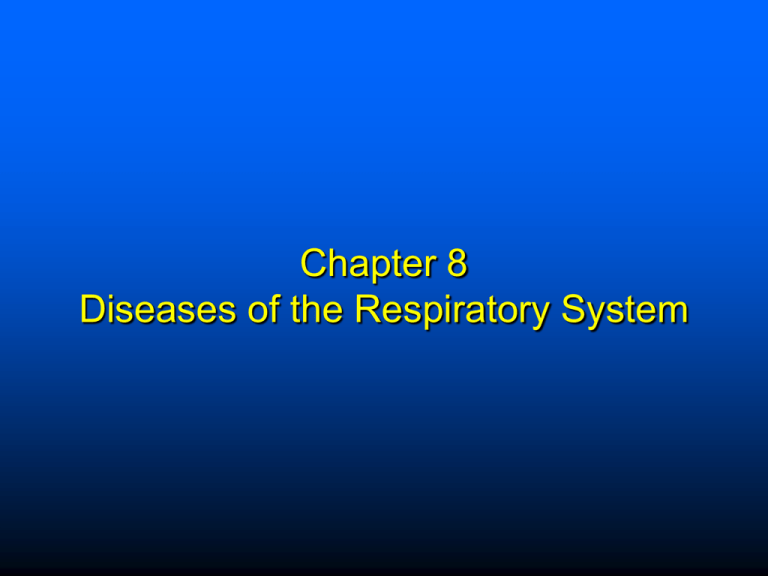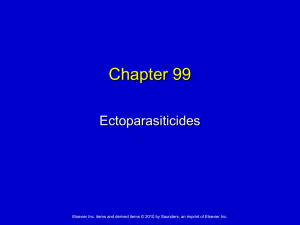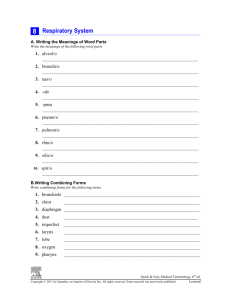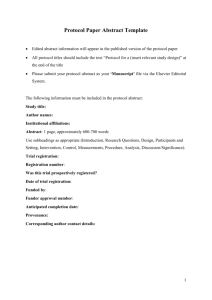Immunologic Diseases and Conditions
advertisement

Chapter 8 Diseases of the Respiratory System Structure and Function Air enters Nasal Cavity, pharynx Larynx to trachea Bronchi – each lung then bronchioles, alveoli Exchange of oxygen for carbon dioxide, expel carbondioxide, oxygen flows into blood system. Diaphragm and muscles between ribs help air to enter and exit lungs. Elsevier items and derived items © 2009 by Saunders, an imprint of Elsevier Inc. 1 Terms Dyspnea Tachypnea Hemoptysis – coughing what? Cyanosis Elsevier items and derived items © 2009 by Saunders, an imprint of Elsevier Inc. 2 Common Signs and Symptoms of respiratory disease Dyspnea Tachypnea, Wheezing Dry cough or hemoptysis Cyanosis Fever Fatigue Pain- where? Weakness – muscles and voice Sinus drainage Elsevier items and derived items © 2009 by Saunders, an imprint of Elsevier Inc. 3 Diagnostic Procedures Sprirometer – tests vital capacity volume, draw in as much air as possible then expel as much as possible. FEV – forced-expiratory volume. Maximum air expelled in one second of time. Oscillometry – Breathe normally for 20-30 seconds, then it shoots sound waves into the air passages and measures echo. Arterial blood gases – evaluate levels of oxygen and carbon dioxide and blood pH Elsevier items and derived items © 2009 by Saunders, an imprint of Elsevier Inc. 4 Diagnostic Procedures Chest x-rays Bronchoscopy Flouroscopy – visualize lungs and diaphragm during respiration Elsevier items and derived items © 2009 by Saunders, an imprint of Elsevier Inc. 5 Upper Respiratory Disease Signs and symptoms Common cold – swelling of mucous membranes, low fever, nasal congestion, cough Sinusitis – inflammation of mucous membranes, pressure, headache, sinus pain, fever Nasal polyps – nasal drainage, lack of smell, sleep apnea Influenza – sudden onset, chills, fever, aches, cough, sore throat, GI disorders Elsevier items and derived items © 2009 by Saunders, an imprint of Elsevier Inc. 6 Upper Respiratory Disease Signs and symptoms Snoring/sleep apnea – postnasal drip, exaggerated breathing sounds, inflamed sinuses, nasal congestion, sleep interruption or hesitation in breathing Hay fever – Runny nose, congestion, tearing, itching Tonsillitis, Pharyngitis, Laryngitis – difficulty swallowing, redness in throat, pain, nasal congestion, loss of voice or hoarseness Elsevier items and derived items © 2009 by Saunders, an imprint of Elsevier Inc. 7 Lower Respiratory Disease Signs and symptoms COPD – includes bronchitis, asthma, emphysema, cystic fibrosis, and pneumonia Bronchitis – chest pains, dyspnea, cough, fever, chills, hypoxia Asthma – breathlessness or panting, wheezing, Emphysema – suffocating feeling, distressed breathing, collapsed lung Cystic Fibrosis – inherited, dyspnea, wheezing, persistent cough, thick sputum Pneumonia – dyspnea, fever, chest pain, productive cough Elsevier items and derived items © 2009 by Saunders, an imprint of Elsevier Inc. 8 Lower Respiratory Disease Signs and symptoms Pleurisy – Painful breathing – complication of pneumonia Legionnaire’s disease – fatigue, coughing, sob, neuromuscular impairments, collapsed lung Primary atypical pneumonia (walking) – flu-like symptoms, fatigue, fever, weakness, headache, sore throat, GI disorders – can become worse, but generally can function among others with this disease Primary TB – Cough with sputum, difficult to diagnose without know contact Elsevier items and derived items © 2009 by Saunders, an imprint of Elsevier Inc. 9






